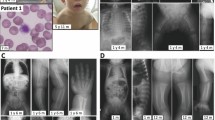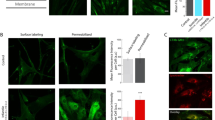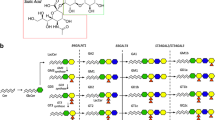Abstract
TAY-SACHS disease is an inborn error of glycosphingolipid metabolism characterised by the accumulation of N-acetyl-galactosaminyl - (N-acetylneuraminyl) - galactosylglucosylcera -mide (GM2) and N-acetylgalactosaminylgalactosylglucosyl-ceramide (GA2) in various tissues of affected individuals1. A defect in the removal of N-acetylgalactosamine from GM2, catalysed by a hexosaminidase, has been demonstrated as the underlying deficiency in all forms of GM2-gangliosidosis2,3. In Tay-Sachs disease this defect has been associated with the absence of one (the A form) of the two major isozymes of β-N-acetylhexosaminidase (Hex A and Hex B)4. Hex A can be differentiated from Hex B in serum, leukocytes, cultured skin and amniotic fluid cells, and urine by using various physical characteristics of these enzymes5. The smaller proportion of A relative to B is the basis of screening for heterozygous carriers of Tay-Sachs disease6.
This is a preview of subscription content, access via your institution
Access options
Subscribe to this journal
Receive 51 print issues and online access
$199.00 per year
only $3.90 per issue
Buy this article
- Purchase on Springer Link
- Instant access to full article PDF
Prices may be subject to local taxes which are calculated during checkout
Similar content being viewed by others
References
Brady, R. O., and Kolodny, E. H., Prog. med. Genet., 8, 225–241 (1972).
Sandhoff, K., Harzer, K., Wassle, H., and Jatzkewitz, H., J. Neurochem., 18, 2469–2489 (1971).
Tallman, J. F., Johnson, W. G., and Brady, R. O., J. clin. Invest., 51, 2339–2345 (1972).
Okada, S., and O'Brien, J. S., Science, 165, 698–700 (1969).
Navon, R., and Padeh, B., Br. med. J., 4, 17–20 (1971); J. Pediat., 80, 1026–1030 (1972); Israel J. Med. Sci., 7, 259–263 (1971).
Kaback, M. M., and Zeiger, R., in Sphingolipids, sphingolipidoses and allied diseases (edited by Volk, B., and Aronson, S.), 613–632 (Plenum, New York, 1972).
Navon, R., Padeh, B., and Adam, A., Am. J. human Genet., 25, 287–293 (1973).
Vidgoff, J., Buist, N., and O'Brien, J. S., Am. J. human Genet., 25, 372–381 (1973).
Percy, A., and Brady, R. O., Science, 161, 594–596 (1968).
Sandhoff, K., FEBS Lett., 11, 342–344 (1970).
Tallman, J. F., Brady, R. O., Quirk, J. M., Villalba, M., and Gal, A., J. biol. Chem., 249, 3489–3499, 1974.
Tallman, J. F., Pentchev, P. G., and Brady, R. O., Enzyme, 18, 136–149 (1974).
Tallman, J. F., Chem. Phys. Lipids, 13, No. 4 (in the press).
O'Brien, J. S., Okada, S., Fillerup, D. L., Veath, M. L., Adornato, B., Brenner, P. H., and Leroy, J. G., Science, 172, 61–64 (1971).
Author information
Authors and Affiliations
Rights and permissions
About this article
Cite this article
TALLMAN, J., BRADY, R., NAVON, R. et al. Ganglioside catabolism in hexosaminidase A-deficient adults. Nature 252, 254–255 (1974). https://doi.org/10.1038/252254a0
Received:
Revised:
Issue Date:
DOI: https://doi.org/10.1038/252254a0
This article is cited by
-
Ganglioside changes in the chicken optic lobes and cerebrum during embryonic development
Wilhelm Roux's Archives of Developmental Biology (1980)
-
Biochemistry and Genetics of gangliosidoses
Human Genetics (1979)
-
Glycosphingolipid hydrolases: Properties and molecular genetics
Molecular and Cellular Biochemistry (1977)
Comments
By submitting a comment you agree to abide by our Terms and Community Guidelines. If you find something abusive or that does not comply with our terms or guidelines please flag it as inappropriate.



